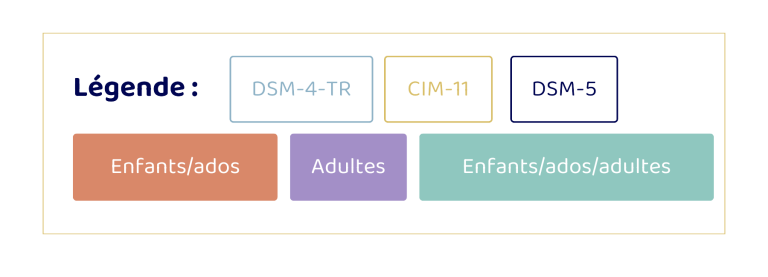Know the evaluation scales
You are a healthcare professional or psychologist and you are accompanying a person who meets at least one of the following criteria:
- has experienced one or more potentially traumatic events,
- presents warning signs of psychotraumatic distress or suffering,
- has one or more mental health disorders frequently associated with PTSD,
- belongs to a population at risk because of their profession or life history.
In this context, you'd like to find out more about identifying PTSD.
You are a researcher and your work :
- focus on PTSD or complex PTSD, which may be your primary endpoint, a secondary endpoint or a factor to be taken into account in your analysis,
- do not include people with PTSD or complex PTSD.
With this in mind, you're looking for the right tools to meet your objectives.
There are a number of tools available to help you make the process easier. They fall into two categories and serve different different objectives: screening and diagnostic evaluation.
ZOOM
Our best practice file "Identifying post-traumatic stress disorder" for professionals and researchers.
Discover: screening and diagnostic evaluation questionnaires, a guide to choosing a questionnaire, taking precautions for its use and ensuring its reliability, and the advantages and disadvantages of using questionnaires.
Screening tools
Screening tools can detect the probable existence of a disorder, but cannot be used to make a diagnosis.
Today, the only screening tools available for PTSD are self-assessment questionnaires. In adults, these are completed by the person concerned themselves. In children, their administration varies according to age and comprehension skills. If the child is unable to attend, they are completed by the reference persons (parents in particular).
These questionnaires assess post-traumatic or symptomatic manifestations of PTSD. For each one, the respondent is asked to rate its frequency of occurrence or intensity, sometimes over a given period. Depending on how the scale is scored, individuals with a score above or equal to a threshold are identified as being at high risk of developing the disorder or psychological construct.
Diagnostic assessment tools
Diagnostic assessment tools support the diagnosis of a disorder, confirming its presence and sometimes its severity, but they do not provide any information on the differential diagnosis or overall clinical assessment of the beneficiary, which is still mandatory.
Today, diagnostic assessment tools for PTSD take the form of semi-structured, hetero-administered interviews that assess the frequency and intensity of PTSD symptoms over a given period. According to the tool's scoring method, individuals who score at or above a threshold have the disorder. Severity thresholds can often be calculated, giving an idea of the severity of the disorder.
They are complex to administer and require the expertise of the professional using them. The knowledge required covers the disorder being assessed, as well as the principles of psychometric evaluation and test interpretation. Mastering them requires training.
Precautions to take when using a questionnaire in a psychological assessment
For professionals
To ensure the relevance and effectiveness of a questionnaire evaluation, it is essential to :
- Clarify objectives and procedures with the beneficiary. This fosters a climate of trust and gives meaning to the process.
- Obtain informed consent and encourage active participation. This is a key success factor.
- Create a caring space where people feel listened to and respected. Answering their questions and concerns facilitates their commitment and encourages constructive collaboration. In this way, the assessment is not limited to a simple measurement: it becomes an opportunity for support, helping the person to better understand his or her psychological functioning.
- Reporting the results. This sheds light on the person's situation, and can help them better understand their experience. To promote this understanding, we recommend using clear, accessible language, adapting explanations to the person's specific needs. This moment of exchange gains in relevance when it puts into perspective the initial request, the concerns expressed, the anamnesis and the results of the questionnaires.
- Explicitly state the symptoms identified and, where appropriate, the diagnosis made. This can help the person to better understand his or her psychological difficulties. Illustrating these elements with concrete examples from everyday life, using your own words and experiences, helps to anchor the results in your reality and make the conclusions more comprehensible.
- Respond sympathetically to the reactions triggered by the results: appeasement and relief, but also concerns and doubts. This fosters a constructive exchange and opens the way to appropriate support solutions.
For those concerned
You're about to take a self-test for a mental health disorder. Whatever the result, bear in mind that no psychological test is 100% reliable. In other words, there's always a risk that the test will be :
- False-negative and undetected even though you have the disease,
- False positive and you are detected even though you do not have the disease.
Therefore, if you have any doubts or feel unwell after the test, even if the result is negative, we recommend that you speak to your GP or consult a specialist healthcare professional (see map of healthcare centers in France here).
Screening and diagnostic evaluation questionnaires
Some scales are not available for download, such as :
- ITI: currently being validated
- UCLA: currently being validated
- CAPS-5: need for training to pass the test
- ITQ-CA: French version not validated




